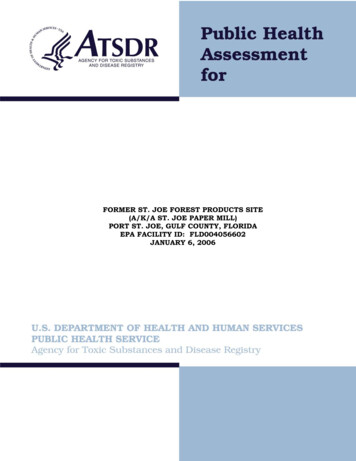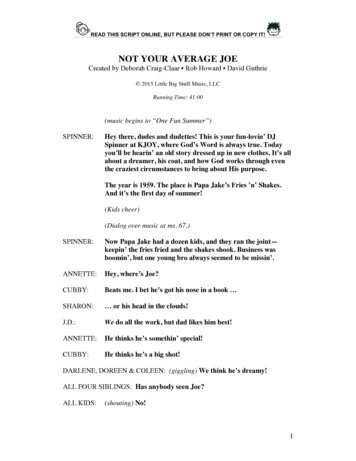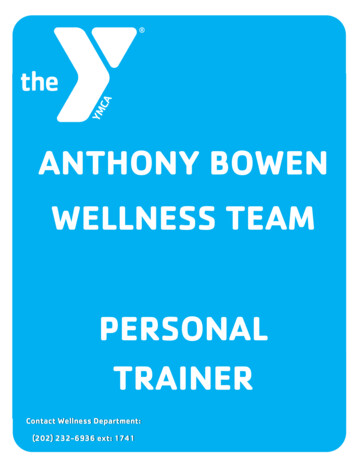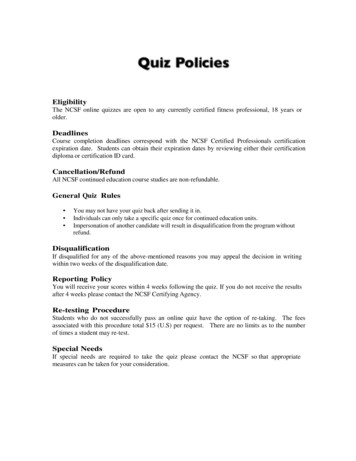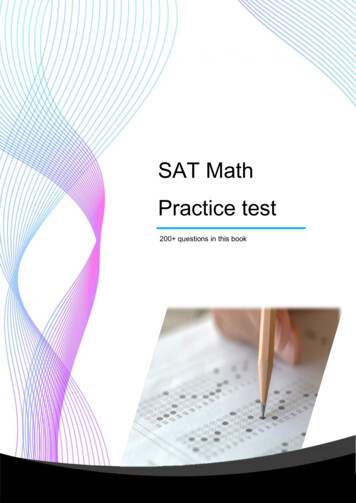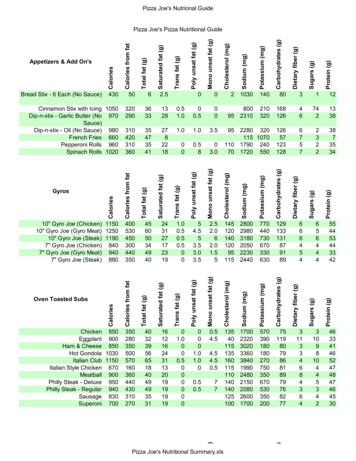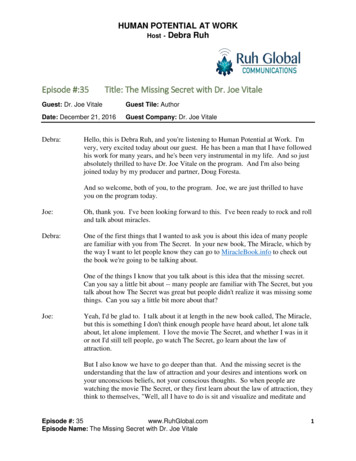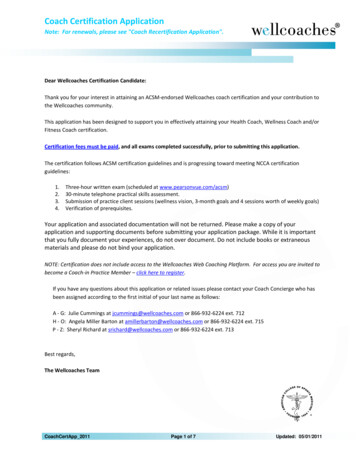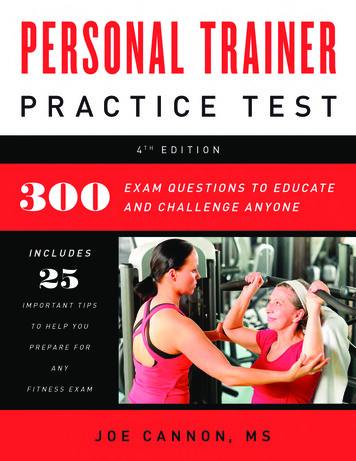
Transcription
Personal Trainer Practice Test4th EditionJoe Cannon, MSJoe-Cannon.comSupplement-Geek.com
Joe Cannon, MS (Joe-Cannon.com)Copyright and Legal StuffCopyright 2015 by Joe Cannon of Joe-Cannon.com.This Personal Trainer Practice Test is not to be copied or resold without the permission ofthe author, Joe Cannon. People not affiliated with Joe Cannon who sell this book withoutauthorization will be prosecuted to the fullest extent of the law. Please contact me (Joe Cannon)if you believe this is occurring.Obviously, I can’t guarantee that if you pass this practice test, you also would pass a “real”fitness trainer certification exam. While I have made every reasonable attempt to achievecomplete accuracy with regard to the contents of this guide, I can’t assume any responsibilityfor errors, contradictory information, or omissions. Any perceived slights or insults of people ororganizations are unintentional.DisclaimerYou do know that this is just a practice test, right? You also know that if you pass this practicetest, besides maybe a congrats from me, you’re not going to get any kind of fitness certificationfrom me (or anyone else)?You should also know that if you pass this practice test, I’m not guaranteeing that you are goingto pass any real certification exam that you take in the future.You should also know that taking a mere practice test isn’t enough to fully prepare anyone topass an actual personal training exam.Translation: Don’t be a knucklehead. There are no shortcuts in life. No practice test is asubstitute for actually studying a book about personal training.ii
Joe Cannon, MS (Joe-Cannon.com)Table of ContentsWhat Others Are Saying About This Test ivAbout The Author viAbout this Practice Test viiExercise Science Section 1Anatomy and Physiology Section 12Fitness Testing Section 23Exercise Program Design Section 34Nutrition and Sports Nutrition Section 45Answers to the Test 56Answers: Exercise Science Section 57Answers: Anatomy and Physiology Section 59Answers: Fitness Testing Section 61Answers: Exercise Program Design Section 63Answers: Nutrition and Sports Nutrition 65ScoringSection 67Top 25 Tips 70My Books 72What Did You Think? 72iii
Joe Cannon, MS (Joe-Cannon.com)What Others Are Saying About This TestHolly Chisholm Hargrave, BA, MBAFounder and CEO www.AthleticGenius.comJoe Cannon’s Personal Trainer Practice Test guide is the BEST tool I have ever utilized to preparemyself for a fitness exam. I am a Master Personal Trainer with sixteen international certifications,so trust me—I have taken many a practice test that ill-prepared me . . . Joe cuts to the chase . . .With clarity he communicates exactly what you need to know to perform well on your exam. Iwouldn’t consider another source other than Joe Cannon.Wajeeha El Bey, CPT, CHHC, AADPwww.TheSoulisticCircle.comI initially failed my ACE exam by seven points! Joe reached out via Facebook to me and gave mehis test. The test really pulled out the main concepts I needed. The questions were well-writtenand narrowed down my focus. These are some of the best example test questions you will findpassed my ACE exam twelve days later and know it was with Joe’s support. Get this test. Youwon’t regret it.Greg Sims, Co-founder of the Interactive Fitness Trainers Associationwww.ifta-fitness.comJoe Cannon’s Personal Trainer Practice Test is well designed and thorough in content. Frombeginning to end I found it to be functional, just like his text “Personal Fitness Training: Beyondthe Basics.” I especially liked the way it was broken down into sections and the scoring systemthat allows you to really understand what you need to study in order to improve. I wouldrecommend it to anyone who is studying for a Personal Trainer test — or anyone who wants toimprove their test taking ability.William Sukala, PhDwww.DrBillSukala.com.auAs both a clinical exercise physiologist and former presenter of the American Council onExercise exam preparation course, I can guarantee that Joe Cannon’s practice test is an excellentresource to facilitate the studying process. If you understand the science behind WHY thecorrect answers are correct, you will have a decided edge when you sit your exam.iv
Joe Cannon, MS (Joe-Cannon.com)Joanne Smith-Tavener, M.Ed., CSCS*DWellness Coordinator, NJSP and AAAI/ISMA Faculty Instructorwww.BreastCancerAndExercise.comI have been in the fitness industry for over twenty years, and as a fellow AAAI/ISMA facultyinstructor, I would highly recommend the use of this practice exam in preparing for our PersonalFitness Instructor Exam. It is comprehensive in its content and focuses on the primary topics ofstudy.Dwayne WimmerOwner, Vertex Fitness Personal Training Studiowww.VertexFit.comGreat job, Joe, putting together one of the most comprehensive practice tests I have seen inthe fitness industry. If someone knew the information in the five sections— Exercise Science,Anatomy & Physiology, Fitness Testing, Exercise Program Design, and Nutrition & SportsNutrition—I feel they would be well on their way to understanding what they need to know tobe a professional in the fitness industry. I highly recommend using this Personal Trainer PracticeTest as a resource for anyone starting into the fitness industry as a personal trainer.Jessica Lewis, CPFT, CNCwww.SculptUrLife.comJoe has such an outstanding track record for training the trainers, it’s no surprise that hisPractice Test crosses all major fitness organizations’ curriculums and is LOADED with real-lifeinformation.Mike Rickett M.S., C.S.C.S., C.S.P.S.www.MichaelRickett.comThis test provides an efficient way to prepare for fitness certifications through anyorganization. It’s also a great way to review your knowledge and practice your test-takingabilities.Debra Mazda, ME.d., CPTPresident/CEO, ShapelyGirl Fitnesswww.ShapelyGirlFitness.comWithout hesitation, I can say that Joe’s knowledge of fitness, exercise, and science is outstanding.Joe is my go-to guy when I have any questions about nutrition, research, health, or fitness. Ihighly recommend anything that he writes.v
Joe Cannon, MS (Joe-Cannon.com)About The AuthorI’m Joe Cannon, and I created this practice test to help give you an idea of some of theinformation you will need to be familiar with as a personal trainer and, hopefully, to help youpass a fitness certification exam.I have an MS degree in exercise science and a BS degree in chemistry and biology. As forcertifications, I am a CSCS and NSCA-CPT. I’ve worked in health clubs and I have been selfemployed since about 2002.Today, I am a personal trainer, teacher, blogger, and consultant.What sets me apart from others is that I train the trainers. I TEACH personal training and sportsnutrition seminars and have done so for over a decade. This gives me a unique insight into whattrainers know and don’t know. In fact, some of the questions I’ve been asked in class have beenused in this test to make it more realistic. This test contains real-life questions that you mightnot find elsewhere.Previously, I’ve written several other books. You can learn more about all of them here:http://www.joe-cannon.com/booksOn my personal website, I write A LOT about personal training. Take advantage of it. I discussissues that very few others do. My goal is simple: I want you to know what I know. That way,you can avoid the mistakes others have made—including me.Ok, enough about me, let’s talk about the practice test vi
Joe Cannon, MS (Joe-Cannon.com)About this Practice TestThis practice test has 300 questions. It is divided into five sections. These are the main sectionscovered on most fitness certification tests:1.Exercise Science:60 questions2.Anatomy & Physiology:60 questions3.Fitness Testing:60 questions4.Exercise Program Design:60 questions5.Nutrition & Sports Nutrition:60 questionsThe answers to all the questions are listed at the end of this book.Scoring the TestTo pass a section, you need a score of at least 80%. You can score each section separately at theend of the test. That way, you can see if there are any areas where you need to improve.How to Take This TestTake the test in private. Turn off your cell phone and other distractions. Get a calculator too.Use a stopwatch. Remember, most fitness certification tests have a time limit.Resources PageI’ve created a Resources Page for this test. You can see it here:http://www.joe-cannon.com/test-resourcesThe Resources Page has additional information to help you achieve your goal of becoming apersonal trainer.Top 25 TipsThis test also includes my Top 25 Tips to help you prepare for the actual certification test youwill take. The tips are located at the end of this test.Any questions? Just email me. I answer all emails personally.When you’re ready, turn the page and let’s begin the test.vii
Joe Cannon, MS (Joe-Cannon.com)Exercise ScienceSection1
Joe Cannon, MS (Joe-Cannon.com)1.The aerobic energy system is also called:2.a. Glycolysis . . . . . . . . . . . . . . . . . . . . . . . . . . . . . . . . . . . . . . . b. Krebs cycle . . . . . . . . . . . . . . . . . . . . . . . . . . . . . . . . . . . . . . c. ATP/CP . . . . . . . . . . . . . . . . . . . . . . . . . . . . . . . . . . . . . . . d. Creatine system . . . . . . . . . . . . . . . . . . . . . . . . . . . . . . . . . . . . Muscle fibers are grouped into bundles called:3.a. Endomysium . . . . . . . . . . . . . . . . . . . . . . . . . . . . . . . . . . . . . b. Fasciculus . . . . . . . . . . . . . . . . . . . . . . . . . . . . . . . . . . . . . . . c. Myostatic bundle . . . . . . . . . . . . . . . . . . . . . . . . . . . . . . . . . . . d. None are correct . . . . . . . . . . . . . . . . . . . . . . . . . . . . . . . . . . . The contractile unit of a muscle fiber is called:4.a. GTO . . . . . . . . . . . . . . . . . . . . . . . . . . . . . . . . . . . . . . . . . b. H zone . . . . . . . . . . . . . . . . . . . . . . . . . . . . . . . . . . . . . . . . c. Sarcomere . . . . . . . . . . . . . . . . . . . . . . . . . . . . . . . . . . . . . . d. Myofillament . . . . . . . . . . . . . . . . . . . . . . . . . . . . . . . . . . . . . The cellular reservoir of calcium for muscle cell contraction is found in the:5.a. Sarcomere junction . . . . . . . . . . . . . . . . . . . . . . . . . . . . . . . . . . b. Sarcoplasmic reticulum . . . . . . . . . . . . . . . . . . . . . . . . . . . . . . . c. Calcium basin . . . . . . . . . . . . . . . . . . . . . . . . . . . . . . . . . . . . d. None are correct . . . . . . . . . . . . . . . . . . . . . . . . . . . . . . . . . . . The breakdown of ATP is:6.a. Aerobic . . . . . . . . . . . . . . . . . . . . . . . . . . . . . . . . . . . . . . . . b. Anaerobic . . . . . . . . . . . . . . . . . . . . . . . . . . . . . . . . . . . . . . . c. Both A and C are correct . . . . . . . . . . . . . . . . . . . . . . . . . . . . . . . d. None are correct . . . . . . . . . . . . . . . . . . . . . . . . . . . . . . . . . . . Calcium alters the shape of which protein to facilitate muscle contraction?7.a. Actin . . . . . . . . . . . . . . . . . . . . . . . . . . . . . . . . . . . . . . . . . b. Myostatin . . . . . . . . . . . . . . . . . . . . . . . . . . . . . . . . . . . . . . . c. Troponin . . . . . . . . . . . . . . . . . . . . . . . . . . . . . . . . . . . . . . . d. Myosin . . . . . . . . . . . . . . . . . . . . . . . . . . . . . . . . . . . . . . . . To which protein do cross bridges attach during muscle contraction?a.Fasciculus . . . . . . . . . . . . . . . . . . . . . . . . . . . . . . . . . . . . . . . 2
Joe Cannon, MS (Joe-Cannon.com)8.b. The H zone . . . . . . . . . . . . . . . . . . . . . . . . . . . . . . . . . . . . . . c. Myofibers . . . . . . . . . . . . . . . . . . . . . . . . . . . . . . . . . . . . . . . d. None are correct . . . . . . . . . . . . . . . . . . . . . . . . . . . . . . . . . . . The enzyme that breaks down ATP is called:9.a. ATP enzyme . . . . . . . . . . . . . . . . . . . . . . . . . . . . . . . . . . . . . b. ATPase . . . . . . . . . . . . . . . . . . . . . . . . . . . . . . . . . . . . . . . . c. No enzyme is needed . . . . . . . . . . . . . . . . . . . . . . . . . . . . . . . . . d. Myostatin . . . . . . . . . . . . . . . . . . . . . . . . . . . . . . . . . . . . . . . The muscle fiber that contracts the fastest is:a. Type I . . . . . . . . . . . . . . . . . . . . . . . . . . . . . . . . . . . . . . . . b. Type Ia . . . . . . . . . . . . . . . . . . . . . . . . . . . . . . . . . . . . . . . . c. Type IIb . . . . . . . . . . . . . . . . . . . . . . . . . . . . . . . . . . . . . . . d. Type IIa . . . . . . . . . . . . . . . . . . . . . . . . . . . . . . . . . . . . . . . 10. In muscle physiology, the A band is to myosin what the I band is to:a. Sarcomere . . . . . . . . . . . . . . . . . . . . . . . . . . . . . . . . . . . . . . b. Actin . . . . . . . . . . . . . . . . . . . . . . . . . . . . . . . . . . . . . . . . . c. B band . . . . . . . . . . . . . . . . . . . . . . . . . . . . . . . . . . . . . . . . d. Purkinje . . . . . . . . . . . . . . . . . . . . . . . . . . . . . . . . . . . . . . . 11. The fiber type that shows the most hypertrophy is:a. Type I . . . . . . . . . . . . . . . . . . . . . . . . . . . . . . . . . . . . . . . . b. Type II . . . . . . . . . . . . . . . . . . . . . . . . . . . . . . . . . . . . . . . . c. Type III . . . . . . . . . . . . . . . . . . . . . . . . . . . . . . . . . . . . . . . . d. Both A and C are correct . . . . . . . . . . . . . . . . . . . . . . . . . . . . . . . 12. Activity not related to formal exercise is called:a. EPOC . . . . . . . . . . . . . . . . . . . . . . . . . . . . . . . . . . . . . . . . b. NEAT . . . . . . . . . . . . . . . . . . . . . . . . . . . . . . . . . . . . . . . . c. Isokinetic . . . . . . . . . . . . . . . . . . . . . . . . . . . . . . . . . . . . . . . d. None are correct . . . . . . . . . . . . . . . . . . . . . . . . . . . . . . . . . . . 13. Fat is broken down for fuel in this area of the cell:a.b.c.Sarcoplasmic reticulum . . . . . . . . . . . . . . . . . . . . . . . . . . . . . . . . Mitochondria . . . . . . . . . . . . . . . . . . . . . . . . . . . . . . . . . . . . . Myostatin system . . . . . . . . . . . . . . . . . . . . . . . . . . . . . . . . . . . 3
Joe Cannon, MS (Joe-Cannon.com)d. Nucleus . . . . . . . . . . . . . . . . . . . . . . . . . . . . . . . . . . . . . . . . 14. The following muscle fiber type that generates the most power is:a. Type I . . . . . . . . . . . . . . . . . . . . . . . . . . . . . . . . . . . . . . . . b. Type Ia . . . . . . . . . . . . . . . . . . . . . . . . . . . . . . . . . . . . . . . . c. Type IIa . . . . . . . . . . . . . . . . . . . . . . . . . . . . . . . . . . . . . . . d. Type IIb . . . . . . . . . . . . . . . . . . . . . . . . . . . . . . . . . . . . . . . 15. Which muscle fiber type would be used the most during a marathon (26.2 miles)?a. Slow twitch, type IIa . . . . . . . . . . . . . . . . . . . . . . . . . . . . . . . . . b. Slow twitch, type I . . . . . . . . . . . . . . . . . . . . . . . . . . . . . . . . . . c. Fast twitch, type I . . . . . . . . . . . . . . . . . . . . . . . . . . . . . . . . . . d. Fast twitch, type IIb . . . . . . . . . . . . . . . . . . . . . . . . . . . . . . . . . 16. The act of holding the breath while weight lifting is called:a. Maximal inhalation . . . . . . . . . . . . . . . . . . . . . . . . . . . . . . . . . . b. Orthostatic hypotension . . . . . . . . . . . . . . . . . . . . . . . . . . . . . . . c. Valsalva maneuver . . . . . . . . . . . . . . . . . . . . . . . . . . . . . . . . . . d. VO2 max . . . . . . . . . . . . . . . . . . . . . . . . . . . . . . . . . . . . . . . 17. The theory that best explains how muscles work is called:a. Sarcoplasmic recycling theory . . . . . . . . . . . . . . . . . . . . . . . . . . . . b. Myostatin regeneration theory . . . . . . . . . . . . . . . . . . . . . . . . . . . . c. Sliding filament theory . . . . . . . . . . . . . . . . . . . . . . . . . . . . . . . . d. Myosin cross-bridge theory . . . . . . . . . . . . . . . . . . . . . . . . . . . . . . 18. The loss of muscle strength and size as we get older is called:a. Atrophy . . . . . . . . . . . . . . . . . . . . . . . . . . . . . . . . . . . . . . . b. Hyperplasia . . . . . . . . . . . . . . . . . . . . . . . . . . . . . . . . . . . . . . c. Myopenia . . . . . . . . . . . . . . . . . . . . . . . . . . . . . . . . . . . . . . . d. Sarcopenia . . . . . . . . . . . . . . . . . . . . . . . . . . . . . . . . . . . . . . 19. The best way to avoid the Valsalva maneuver is:a. Contract the abs . . . . . . . . . . . . . . . . . . . . . . . . . . . . . . . . . . . b. Strengthen the rotator cuff . . . . . . . . . . . . . . . . . . . . . . . . . . . . . . c. Breath during exercise . . . . . . . . . . . . . . . . . . . . . . . . . . . . . . . . d. None are correct . . . . . . . . . . . . . . . . . . . . . . . . . . . . . . . . . . . 20. Hypertrophy refers to an:4
Joe Cannon, MS (Joe-Cannon.com)a. Increase in myostatin content . . . . . . . . . . . . . . . . . . . . . . . . . . . . . b. Increase in muscle size . . . . . . . . . . . . . . . . . . . . . . . . . . . . . . . . c. Increase in muscle cell number . . . . . . . . . . . . . . . . . . . . . . . . . . . . d. Increase in Purkinje fiber number . . . . . . . . . . . . . . . . . . . . . . . . . . 21. A term that refers to an increase in cell muscle cell number is:a. Hypertrophy . . . . . . . . . . . . . . . . . . . . . . . . . . . . . . . . . . . . . b. Myotrophy . . . . . . . . . . . . . . . . . . . . . . . . . . . . . . . . . . . . . . c. Hyperplasia . . . . . . . . . . . . . . . . . . . . . . . . . . . . . . . . . . . . . . d. Sarcoplasm . . . . . . . . . . . . . . . . . . . . . . . . . . . . . . . . . . . . . . 22. Which might you expect in a person who runs three miles a day, four days a week?a. High blood pressure at rest . . . . . . . . . . . . . . . . . . . . . . . . . . . . . . b. Low resting heart rate . . . . . . . . . . . . . . . . . . . . . . . . . . . . . . . . . c. Decreased VO2 max . . . . . . . . . . . . . . . . . . . . . . . . . . . . . . . . . d. Both B and C are correct . . . . . . . . . . . . . . . . . . . . . . . . . . . . . . . 23. A person from Pennsylvania trains in Colorado for three months. What would beexpected?a. Decreased calorie burning . . . . . . . . . . . . . . . . . . . . . . . . . . . . . . b. Increased RBC concentration . . . . . . . . . . . . . . . . . . . . . . . . . . . . . c. Decreased RBC concentration . . . . . . . . . . . . . . . . . . . . . . . . . . . . d. Both A and B are correct . . . . . . . . . . . . . . . . . . . . . . . . . . . . . . . 24. In exercise science, DOMS refers to:a. Female athletic triad . . . . . . . . . . . . . . . . . . . . . . . . . . . . . . . . . b. Dehydration . . . . . . . . . . . . . . . . . . . . . . . . . . . . . . . . . . . . . c. Type I fiber dominance . . . . . . . . . . . . . . . . . . . . . . . . . . . . . . . . d. Muscle soreness . . . . . . . . . . . . . . . . . . . . . . . . . . . . . . . . . . . . 25. A healthy twenty-five-year-old joins a boot camp fitness class. The next day he noticesthat his urine is dark-brown coloreWhat might you suspect?a. DOMS . . . . . . . . . . . . . . . . . . . . . . . . . . . . . . . . . . . . . . . . b. Dehydration . . . . . . . . . . . . . . . . . . . . . . . . . . . . . . . . . . . . . c. Rhabdomyolysis . . . . . . . . . . . . . . . . . . . . . . . . . . . . . . . . . . . d. Excess B vitamins in the diet . . . . . . . . . . . . . . . . . . . . . . . . . . . . . 26. In exercise, the acronym EPOC refers to:a.Increased breathing rate that occurs after exercise . . . . . . . . . . . . . . . . . . . 5
Joe Cannon, MS (Joe-Cannon.com)b. The time period after the active rest phase in periodization . . . . . . . . . . . . . . c. Decrease in metabolic rate . . . . . . . . . . . . . . . . . . . . . . . . . . . . . . d. None are correct . . . . . . . . . . . . . . . . . . . . . . . . . . . . . . . . . . . 27. Metabolic rate can be viewed as being composed of:a. RMR x blood pressure . . . . . . . . . . . . . . . . . . . . . . . . . . . . . . . . b. Cardiovascular strength training . . . . . . . . . . . . . . . . . . . . . . . . . . c. Anabolism catabolism . . . . . . . . . . . . . . . . . . . . . . . . . . . . . . . d. VO2 max x blood pressure . . . . . . . . . . . . . . . . . . . . . . . . . . . . . . 28. The amount of blood pumped from the heart per minute is called:a. Ejection fraction . . . . . . . . . . . . . . . . . . . . . . . . . . . . . . . . . . . b. Ejection output . . . . . . . . . . . . . . . . . . . . . . . . . . . . . . . . . . . . c. Cardiac output . . . . . . . . . . . . . . . . . . . . . . . . . . . . . . . . . . . . d. Stoke volume . . . . . . . . . . . . . . . . . . . . . . . . . . . . . . . . . . . . . 29. A common effect of the Valsalva maneuver is:a. Increased VO2 max . . . . . . . . . . . . . . . . . . . . . . . . . . . . . . . . . . b. Increased BP . . . . . . . . . . . . . . . . . . . . . . . . . . . . . . . . . . . . . c. Increased muscle endurance . . . . . . . . . . . . . . . . . . . . . . . . . . . . . d. Increased capillary oxygen extraction . . . . . . . . . . . . . . . . . . . . . . . . . 30. A general term that refers to the loss of muscle size and strength is:a. Sarcopenia . . . . . . . . . . . . . . . . . . . . . . . . . . . . . . . . . . . . . . b. Myopenia . . . . . . . . . . . . . . . . . . . . . . . . . . . . . . . . . . . . . . . c. Atrophy . . . . . . . . . . . . . . . . . . . . . . . . . . . . . . . . . . . . . . . d. Hypotrophy . . . . . . . . . . . . . . . . . . . . . . . . . . . . . . . . . . . . . 31. Which is best for improving a person’s ability to perform push-ups?a. Push-ups . . . . . . . . . . . . . . . . . . . . . . . . . . . . . . . . . . . . . . . b. Bench press, four sets, 80% 1RM . . . . . . . . . . . . . . . . . . . . . . . . . . . c. Supersets: pushups/pull ups . . . . . . . . . . . . . . . . . . . . . . . . . . . . . d. DB bench press, three sets, 75% 10RM . . . . . . . . . . . . . . . . . . . . . . . 32. In exercise science, METs stands for:a.b.c.Metabolic exercise thermogenesis . . . . . . . . . . . . . . . . . . . . . . . . . . . Metabolic equivalents . . . . . . . . . . . . . . . . . . . . . . . . . . . . . . . . . Measured exercise time . . . . . . . . . . . . . . . . . . . . . . . . . . . . . . . . 6
Joe Cannon, MS (Joe-Cannon.com)d. My exercise time . . . . . . . . . . . . . . . . . . . . . . . . . . . . . . . . . . . 33. The cells that carry oxygen through the blood are:a. White blood cells . . . . . . . . . . . . . . . . . . . . . . . . . . . . . . . . . . . b. Erythrocytes . . . . . . . . . . . . . . . . . . . . . . . . . . . . . . . . . . . . . c. Red blood cells . . . . . . . . . . . . . . . . . . . . . . . . . . . . . . . . . . . . d. Both B and C are correct . . . . . . . . . . . . . . . . . . . . . . . . . . . . . . . 34. Which best describes the effect of chronic exercise on blood pressure?a. No change in BP . . . . . . . . . . . . . . . . . . . . . . . . . . . . . . . . . . . b. Lower BP . . . . . . . . . . . . . . . . . . . . . . . . . . . . . . . . . . . . . . . c. Increase BP . . . . . . . . . . . . . . . . . . . . . . . . . . . . . . . . . . . . . . d. Cannot be determined without knowing HR max . . . . . . . . . . . . . . . . . . 35. Another name for fast oxidative glycolytic (FOG) muscle fibers is:a. Type I . . . . . . . . . . . . . . . . . . . . . . . . . . . . . . . . . . . . . . . . b. Type IIa . . . . . . . . . . . . . . . . . . . . . . . . . . . . . . . . . . . . . . . c. Type IIb . . . . . . . . . . . . . . . . . . . . . . . . . . . . . . . . . . . . . . . d. FOG isn’t a muscle fiber type . . . . . . . . . . . . . . . . . . . . . . . . . . . . . 36. In general, which is true about selectoriz
What Others Are Saying About This Test Holly Chisholm Hargrave, BA, MBA Founder and CEO www.AthleticGenius.com Joe Cannon's Personal Trainer Practice Test guide is the BEST tool I have ever utilized to prepare myself for a fitness exam. I am a Master Personal Trainer with sixteen international certifications,
